Flexural Performance of Reinforced Concrete Beams Strengthened with a Novel High-Strength and High-Toughness Epoxy Mortar Thin Layer
Abstract
:1. Introduction
2. Experimental Program
2.1. Specimen Design and Production
2.2. Material Properties
2.2.1. Concrete
2.2.2. Longitudinal Steel Bar
 10 steel bar used in this test has no obvious yield stage and the
10 steel bar used in this test has no obvious yield stage and the  14 steel bar has an obvious yield stage.
14 steel bar has an obvious yield stage.2.2.3. New Epoxy Mortar
2.3. Test Device and Instrumentation
3. Test Results and Analysis
3.1. Test Phenomenon and Failure Modes
3.1.1. Contrast Beam A0
3.1.2. Contrast Beam B0
3.1.3. Strengthened Beam A1
3.1.4. Strengthened Beam B1
3.1.5. Analysis of the Destruction Morphology
3.2. Load–Deflection Curve
3.3. Bearing Capacity Analysis
3.4. Deformation Analysis
4. Calculation of the Bending Bearing Capacity
4.1. Fundamental Assumption
4.2. Material Constitutive Model
4.2.1. Concrete
4.2.2. Longitudinal Steel Bar
 14 used in this study should adopt a double line model (Figure 15a) and the
14 used in this study should adopt a double line model (Figure 15a) and the  10 a double line reinforcement model (Figure 15b). The expression is as follows:
10 a double line reinforcement model (Figure 15b). The expression is as follows:4.2.3. New Epoxy Mortar
4.3. Calculation Formula of Bearing Capacity
4.4. Formula Verification
5. Conclusions
- (1)
- The contrast beams exhibited the typical bending failure modes. The failure mode of the reinforced beam was the yielding of the tensile reinforcement of the original beam and then fracture damage of the new epoxy mortar-reinforced thin layer.
- (2)
- No debonding phenomenon was observed between the reinforced thin layer and the original concrete, and no visible cracks appeared before the tensile failure occurred in the thin layer.
- (3)
- Compared with the corresponding contrast beams, the cracking load of the reinforcement beams A1 and B1 increased by 14% and 23% respectively, the yield load by 32% and 40%, respectively, and the peak load by 18% and 17%, respectively; the number of cracks developed slowly, but the crack width and spacing decreased significantly.
- (4)
- The stiffness of the reinforced beam, especially after cracking, was significantly higher than that of the unreinforced contrast beams, but the deformation ductility coefficient was significantly reduced.
- (5)
- For the calculation method of the epoxy mortar thin layer reinforcement RC beam proposed in this study, the calculated values showed a good agreement with the experimental values, with errors at −11.73% and 4.14%, respectively, which can provide support for related research on such reinforcement methods.
- (6)
- In this study, only two-point flexural tests were carried out on beams without initial stress, and the influence of load holding or immediate damage on the reinforcement effect was not considered. The follow-up plan is to carry out the relevant experimental research to provide a basis for the practical engineering application of the new epoxy mortar thin layer reinforced RC beam.
Author Contributions
Funding
Data Availability Statement
Conflicts of Interest
References
- Ferdosian, I.; Camoes, A. Mechanical performance and post-cracking behavior of self-compacting steel-fiber reinforced eco-efficient ultra-high performance concrete. Cem. Concr. Compos. 2021, 121, 104050. [Google Scholar] [CrossRef]
- Song, S.; Deng, M.; Zhang, M.; Guo, L.; Dong, Z.; Li, P. Flexural strengthening of reinforced concrete beams using textile-reinforced mortar improved with short PVA fibers. Structures 2023, 56, 104824. [Google Scholar] [CrossRef]
- Assad, M.; Hawileh, R.A.; Abdalla, J.A. Flexural strengthening of reinforced concrete beams with CFRP laminates and spike anchors. Compos. Part C Open Access 2024, 13, 100443. [Google Scholar] [CrossRef]
- Qasim, M.; Lee, C.K.; Zhang, Y.X. Flexural strengthening of reinforced concrete beams using hybrid fibre reinforced engineered cementitious composite. Eng. Struct. 2023, 284, 115992. [Google Scholar] [CrossRef]
- Sun, Y.; Fu, W.; Chen, X.; Zhang, Z.; Yu, W.; Li, S. Theoretical and experimental investigations into flexural behavior of existing reinforced concrete beams strengthened by CFRP bars. J. Build. Eng. 2023, 77, 107528. [Google Scholar] [CrossRef]
- Aljidda, O.; Alnahhal, W.; El Refai, A. Flexural strengthening of one-way reinforced concrete slabs using near surface-mounted BFRP bars. Eng. Struct. 2024, 303, 117507. [Google Scholar] [CrossRef]
- Gudonis, E.; Timinskas, E.; Gribniak, V.; Kaklauskas, G.; Arnautov, A.K.; Tamulėnas, V. FRP reinforcement for concrete structures: State-of-the-art review of application and design. Eng. Struct. Technol. 2014, 5, 147–158. [Google Scholar] [CrossRef]
- Wei, B.; He, X.; Zhou, M.; Wang, H.; He, J. Experimental study on flexural behaviors of FRP and steel bars hybrid reinforced concrete beams. Case Stud. Constr. Mater. 2024, 20, e02759. [Google Scholar] [CrossRef]
- Zhang, X.; Liu, G.; Shen, Z.; Gao, Y.; Zhou, H.; Wang, Z. A comprehensive study on the effect of reinforcing methods on the flexural behaviour of Concrete-RUHTCC composite beams. Eng. Struct. 2023, 292, 116524. [Google Scholar] [CrossRef]
- Li, Y.; Zhao, S.-M.; Yao, Z.-A.; Huang, X. Flexural behavior of reinforced concrete beams strengthened using recycled industrial steel-wire mesh high-performance mortar. Case Stud. Constr. Mater. 2023, 19, e02472. [Google Scholar] [CrossRef]
- Wang, W.W.; Zheng, Y.Z. Flexural strengthing RC beams using a composite reinforcement layer FRP grid and ECC. In Proceedings of the 12th International Symposium on Fiber Reinforced Polymers for Reinforced Concrete Structures&the 5th Asia-Pacific Conference on Fiber Reinforced Polymers in Structures (FRPRCS-12/APFIS-2015), Nanjing, China, 14–16 December 2015; pp. 140–146. [Google Scholar]
- Liu, D.; Qin, F.; Di, J.; Zhang, Z. Flexural behavior of reinforced concrete (RC) beams strengthened with carbon fiber reinforced polymer(CFRP)and ECC. Case Stud. Constr. Mater. 2023, 19, e02270. [Google Scholar] [CrossRef]
- Zheng, Y.Z.; Wang, W.W.; Brigham, J.C. Flexural behaviour of reinforced concrete beams strengthened with a composite reinforcement layer: BFRP grid and ECC. Constr. Build. Mater. 2016, 115, 424–437. [Google Scholar] [CrossRef]
- Zhang, K.; Shen, X.; Liu, J.; Teng, F.; Zhang, G.; Wang, J. Flexural strengthening of reinforced concrete T-beams using a composite of prestressed steel wire ropes embedded in polyurethane cement (PSWR-PUC): Theoretical analysis. Structures 2022, 44, 1278–1287. [Google Scholar] [CrossRef]
- Zhang, K.; Qi, T.; Zhu, Z.; Xue, X.; Shen, X. Strengthening of a Reinforced Concrete Bridge with a Composite of Prestressed Steel Wire Ropes Embedded in Polyurethane Cement. J. Perform. Constr. Facil. 2021, 35, 04021063. [Google Scholar] [CrossRef]
- Du, Y.X.; Shao, X.; Chu, S.H.; Zhou, F.; Su, R.K.L. Strengthening of preloaded RC beams using prestressed carbon textile reinforced mortar plates. Structures 2021, 30, 735–744. [Google Scholar] [CrossRef]
- Moy, C.K.S.; Revanna, N. Experimental and DIC Study of Reinforced Concrete Beams Strengthened by Basalt and Carbon Textile Reinforced Mortars in Flexure. Buildings 2023, 13, 1765. [Google Scholar] [CrossRef]
- Wang, W.; Zhu, Z.; Du, J.; Huan, S.; Cao, X. Flexural mechanical behavior of RC beams strengthening with BFRP grid and modified MMA resin concrete. J. Nanchang Univ. (Eng. Technol.) 2019, 41, 127–132. (In Chinese) [Google Scholar] [CrossRef]
- Li, Z.; Shen, A.; Zeng, G.; Chen, Z.; Guo, Y. Research progress on properties of basalt fiber-reinforced cement concrete. Mater. Today Commun. 2022, 33, 104824. [Google Scholar] [CrossRef]
- Yahye, M.A.; Liu, L.; Wu, H.; Sun, Y.; Sun, H.; Ma, J.; Zhang, L. Experimental research on mechanical properties of Fiber-Reinforced Polyurethane Elastic Concrete (FRPEC). Constr. Build. Mater. 2022, 328, 126929. [Google Scholar]
- Lokuge, W.; Aravinthan, T. Effect of fly ash on the behaviour of polymer concrete with different types of resin. Mater. Des. 2013, 51, 175–181. [Google Scholar] [CrossRef]
- Jiang, J.; Sui, K. Experimental study of compression performance of concrete cylinder strengthened by textile reinforced engineering cement composites. Acta Mater. Compos. Sin. 2019, 36, 1957–1967. (In Chinese) [Google Scholar]
- Luo, H.; Yang, D.; Zhou, X.; Shan, C.; Liu, X.; Zhao, F. Mechanical properties of polypropylene fiber reinforced concrete with different aspect ratios. Acta Mater. Compos. Sin. 2019, 36, 1935–1948. (In Chinese) [Google Scholar]
- Cheng, Z.; Yang, K.; Tang, Z.; Ge, F.; Zhou, X.; Zeng, X.; Ma, K.; Long, G. Experimental investigation on flexural and compressive toughness of mortar and concrete with hybrid toughening materials. Structures 2022, 43, 1592–1599. [Google Scholar] [CrossRef]
- Zhang, W.; Deng, M.; Han, Y.; Li, R.; Yang, S. Uniaxial tensile performance of high ductile fiber-reinforced concrete with built-in basalt textile grids. Constr. Build. Mater. 2022, 315, 125716. [Google Scholar] [CrossRef]
- Popa, M.-M.; Leuteritz, A.; Stommel, M.; Kühnert, I.; Mechtcherine, V.; Scheffler, C. Micromechanical study on polypropylene-bicomponent fibers to improve mechanical interlocking for application in strain-hardening cement-based composites. Cem. Concr. Compos. 2023, 142, 105181. [Google Scholar] [CrossRef]
- Ministry of Housing and Urban-Rural Development of the People’s Republic of China. GB/T 50010—2010; Code for Design of Concrete Structures. China Architecture & Building Press: Beijing, China, 2010. (In Chinese)
- Lv, X.; Huang, Y.; Zhang, B.; Peng, G.; Huo, H.; Qu, X.; Guo, H.; Liu, Y. Electrospun poly (arylene ether nitrile) fibers for interlaminar toughening of carbon fiber epoxy composites. Polym. Test. 2024, 130, 108299. [Google Scholar] [CrossRef]
- Meng, Y. Research on Strengthening Theory of Super High Toughness Resin Steel Wire Mesh Concrete and Prestressed Simple Supported Beam Bridge; Southwest Jiaotong University: Chengdu, China, 2021. (In Chinese) [Google Scholar]
- Zhang, K.; Sun, Q. The use of Wire Mesh-Polyurethane Cement (WM-PUC) composite to strengthen RC T-beams under flexure. J. Build. Eng. 2018, 15, 122–136. [Google Scholar] [CrossRef]
- DL/T 5193-2021; Technical Specification of Epoxy Resin Mortar. National Energy Board: Technical Committee on Standardization of Hydropower Construction in Electric Power Industry (DL/TC 29): Beijing, China, 2021.
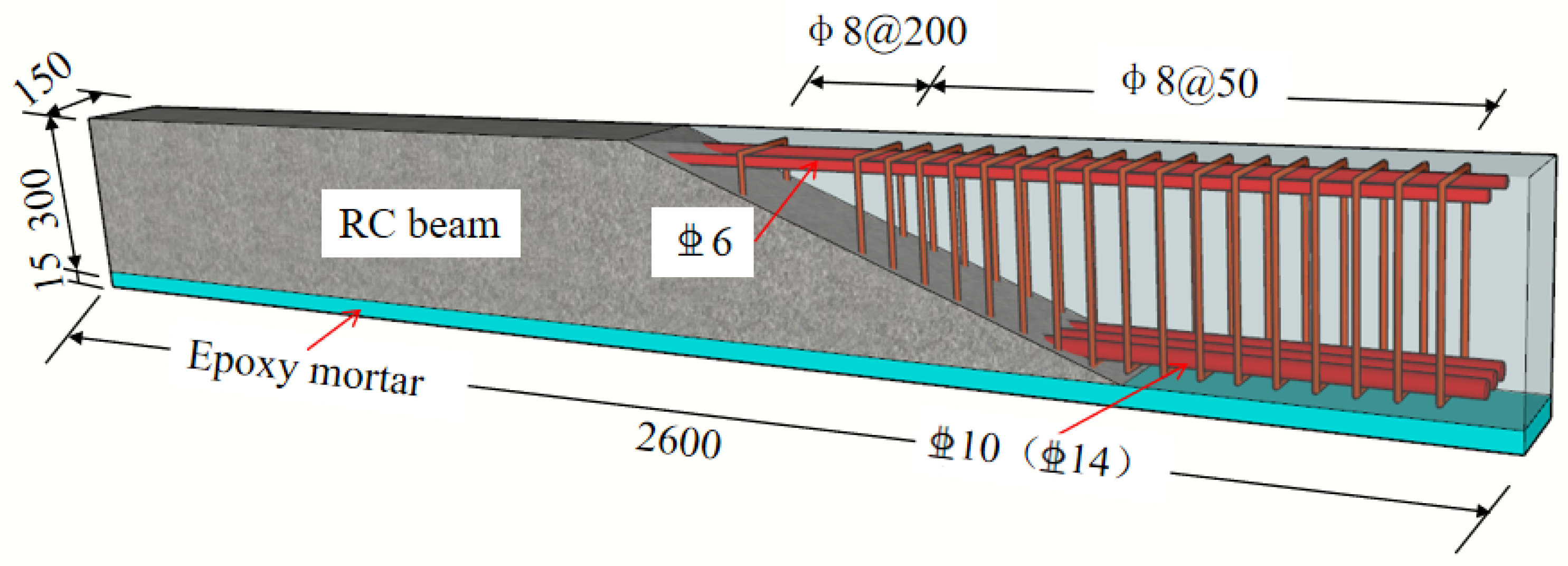

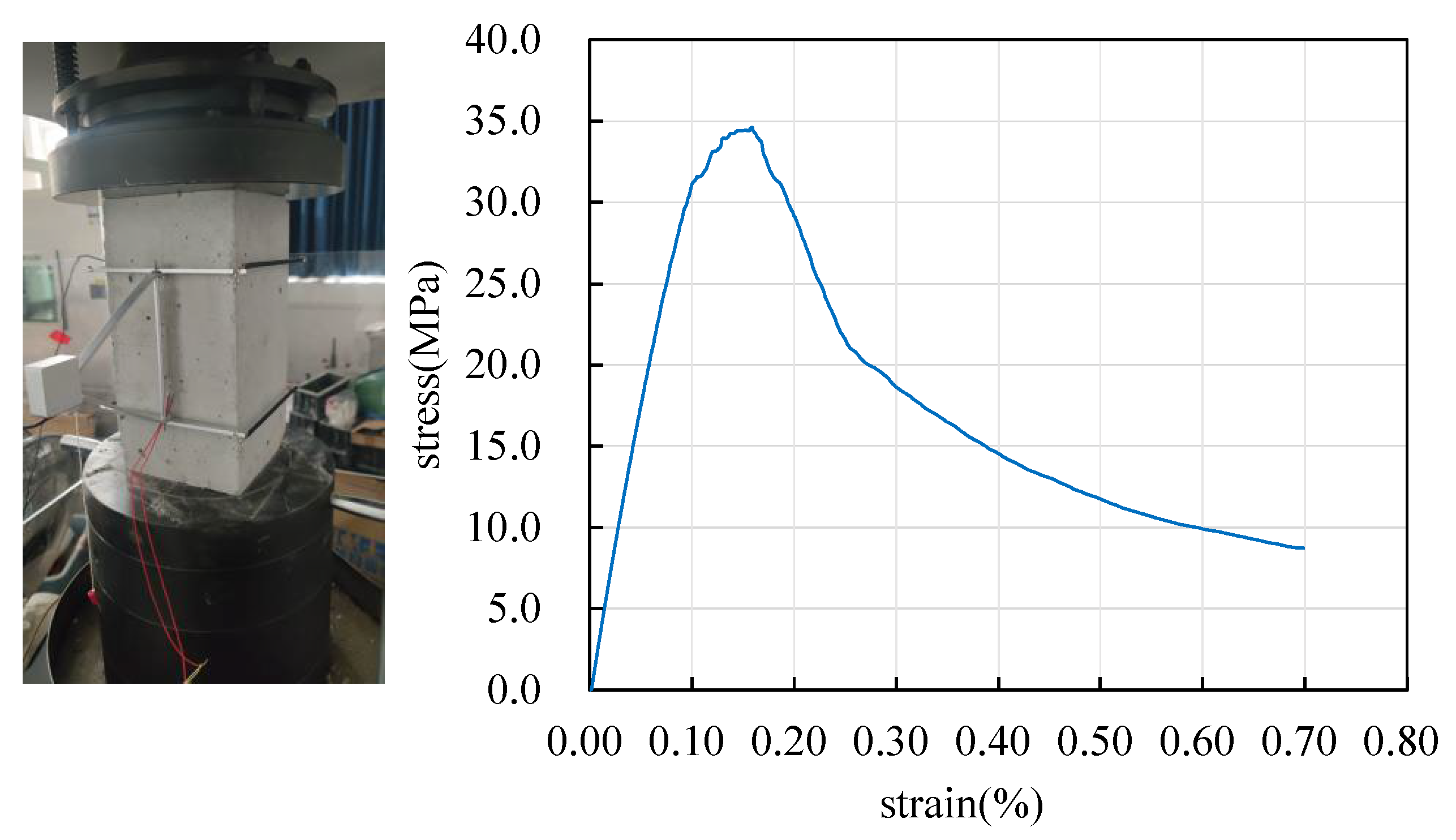
 10; and (b)
10; and (b)  14.
14.
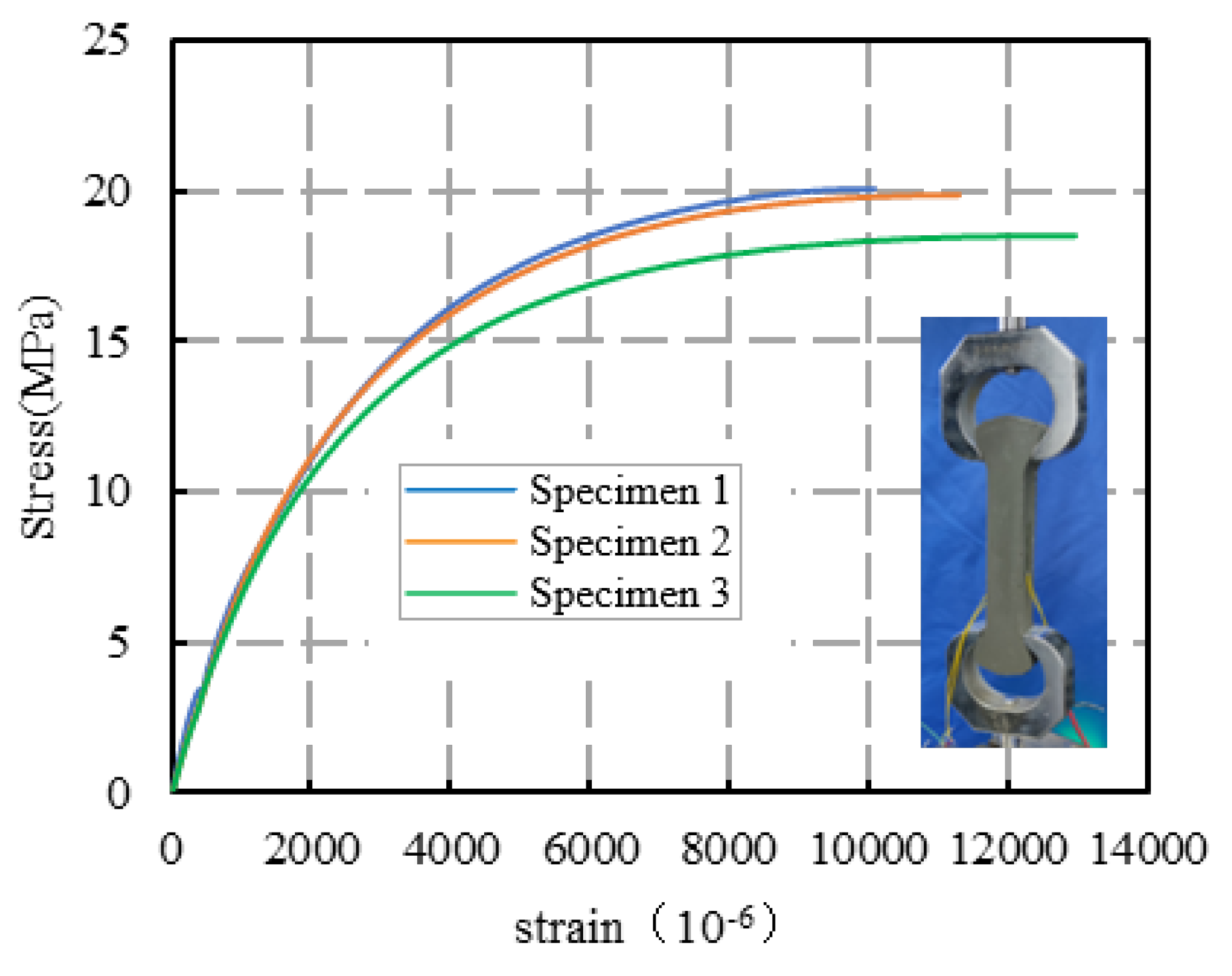
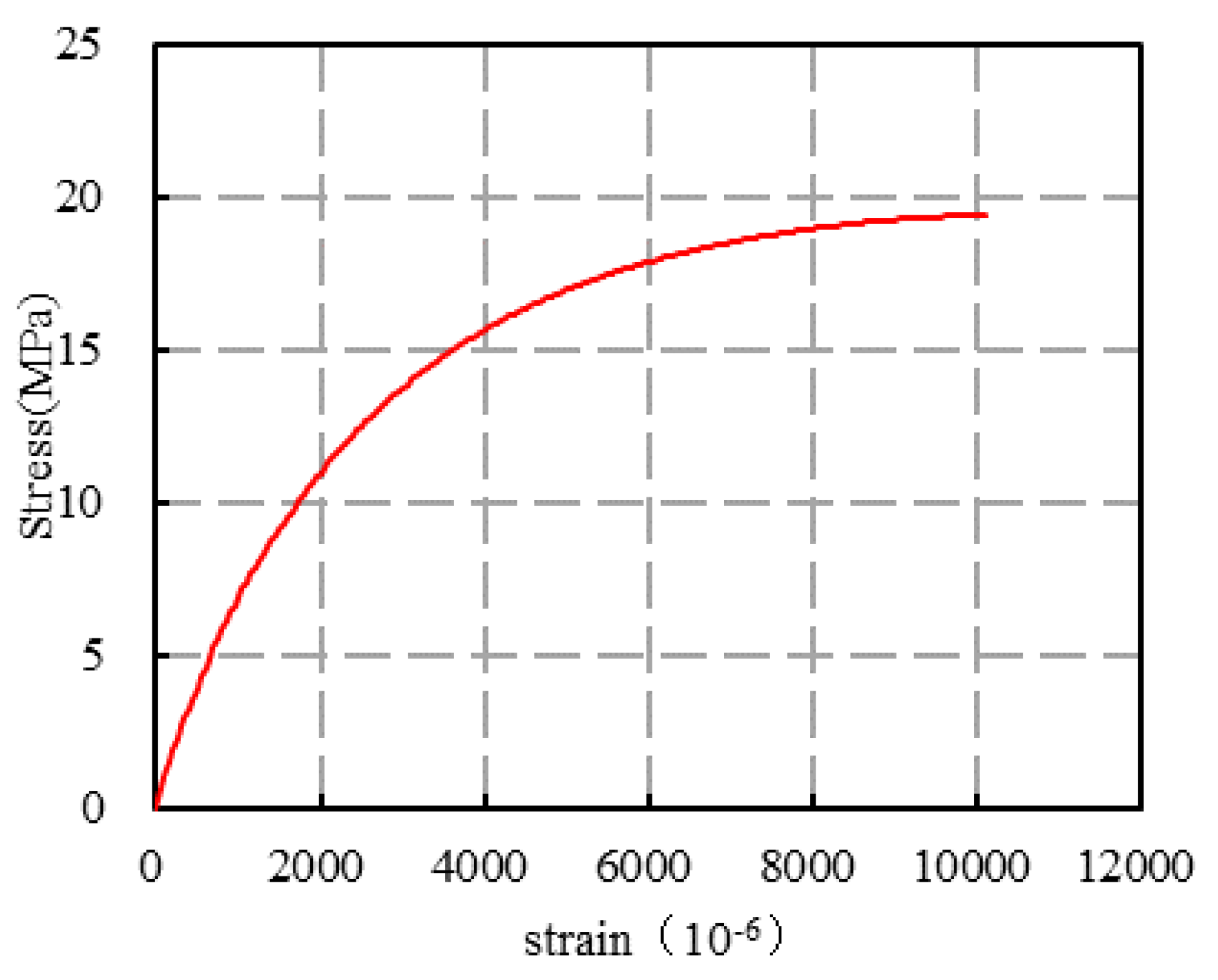

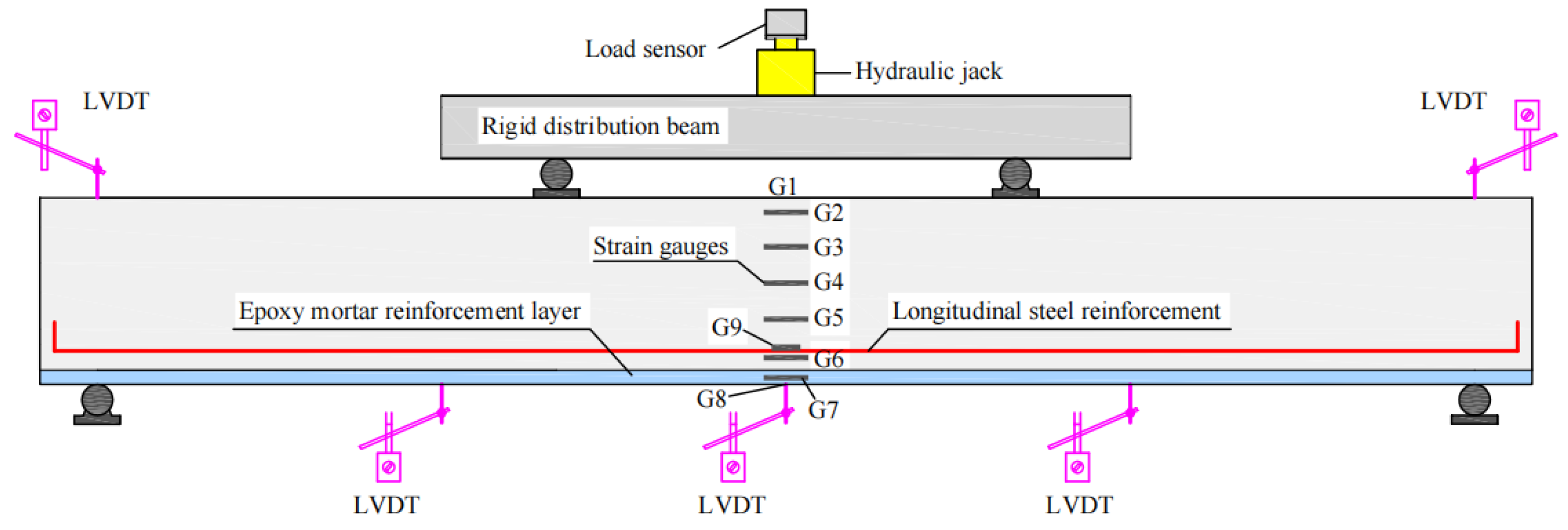
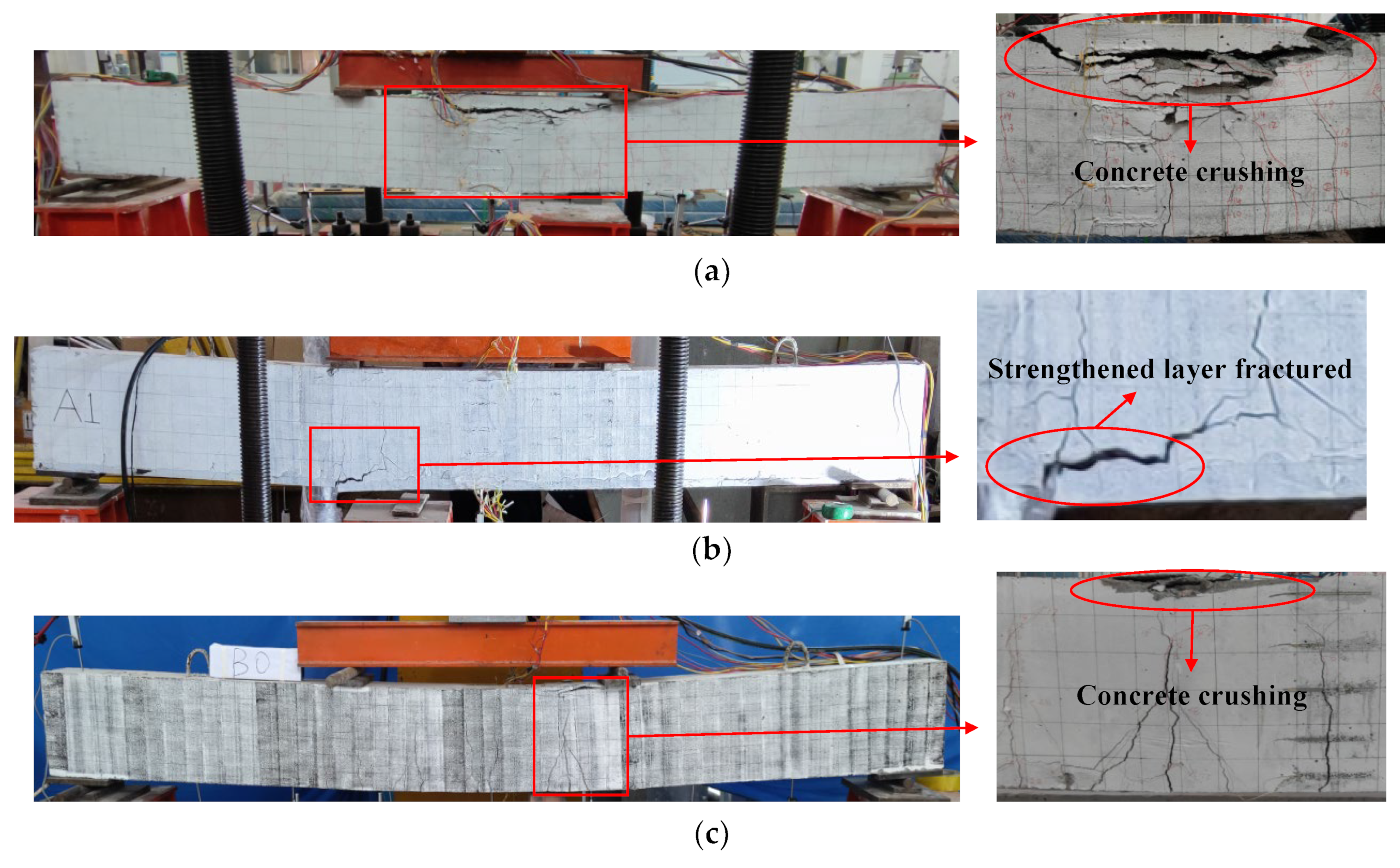




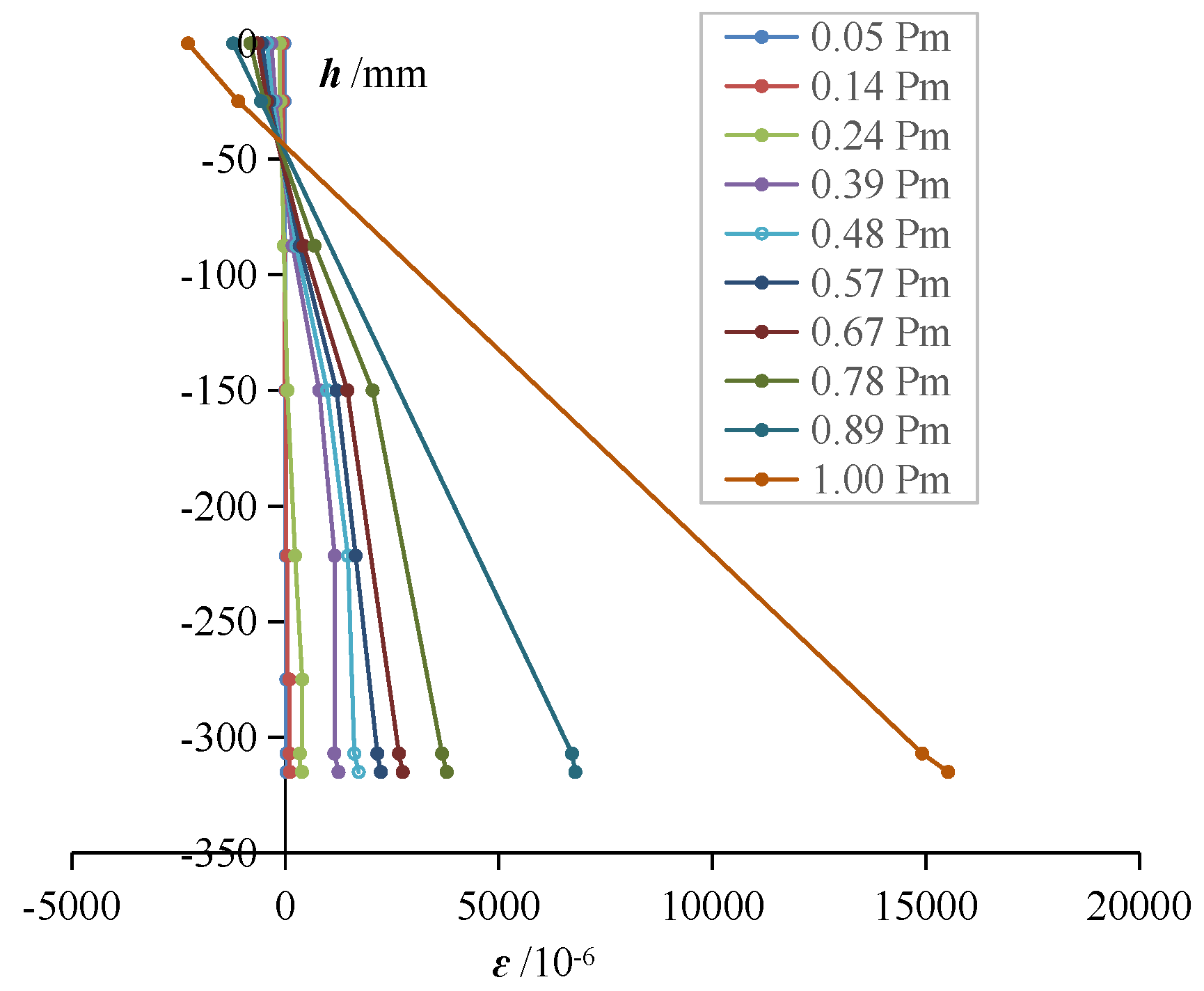




| Beam ID | Longitudinal Steel Bar | Longitudinal Reinforcement Ratio | Reinforcement Thickness/mm |
|---|---|---|---|
| A0 | 3 14 14 | 0.6% | 0 |
| A1 | 3 14 14 | 0.6% | 15 |
| B0 | 3 10 10 | 1.18% | 0 |
| B1 | 3 10 10 | 1.18% | 15 |
| Epoxy Resin | Diluent | Flexibilizer | Defoamer | Curing Agent | Silane Coupling Agent | Fly Ash | Quartz Sand |
|---|---|---|---|---|---|---|---|
| 100 | 10 | 10 | 1.5 | 33 | 3 | 246 | 369 |
| Beam ID | Cracking Point | Yield Point | Peak Point | Limiting Point | μ | Destruction Mode | |||||
|---|---|---|---|---|---|---|---|---|---|---|---|
| Pcr/kN | fcr/mm | Py/kN | fy/mm | Pm/kN | fm/mm | Pu/kN | fu/mm | ||||
| A0 | 26.06 | 0.58 | 119.39 | 7.98 | 143.29 | 28.03 | 121.80 | 30.38 | — | 3.81 | A |
| A1 | 29.72 | 0.60 | 158.22 | 9.53 | 168.72 | 16.45 | 143.41 | 17.55 | 1.18 | 1.84 | B |
| B0 | 19.70 | 0.38 | 64.22 | 6.86 | 86.77 | 49.84 | 73.75 | 50.01 | — | 7.29 | A |
| B1 | 24.26 | 0.59 | 90.27 | 7.17 | 101.61 | 26.30 | 86.37 | 27.97 | 1.17 | 3.90 | B |
| Material Parameter | fcd/MPa | εc0/10−6 | εcu/10−6 | n |
|---|---|---|---|---|
| value | 34.6 | 1600 | 2504 | 2 |
| Materials | E1/MPa | E2/MPa | εy/10−6 | fy/MPa | εcu/10−6 |
|---|---|---|---|---|---|
 10 10 | 200,000 | 4915 | 2500 | 500 | 10,000 |
 14 14 | 200,000 | 0 | 2258 | 452 | 10,000 |
| Material Parameter | σmax/MPa | ε1/10−6 | ε2/10−6 | ε3/10−6 |
|---|---|---|---|---|
| value | 19.40 | 1650 | 4600 | 10,100 |
| Beam ID | Experimental Value/kN | Calculated Value/kN | Deviation/% |
|---|---|---|---|
| A1 | 168.72 | 151.00 | −11.73 |
| B1 | 101.61 | 106.00 | 4.14 |
Disclaimer/Publisher’s Note: The statements, opinions and data contained in all publications are solely those of the individual author(s) and contributor(s) and not of MDPI and/or the editor(s). MDPI and/or the editor(s) disclaim responsibility for any injury to people or property resulting from any ideas, methods, instructions or products referred to in the content. |
© 2024 by the authors. Licensee MDPI, Basel, Switzerland. This article is an open access article distributed under the terms and conditions of the Creative Commons Attribution (CC BY) license (https://creativecommons.org/licenses/by/4.0/).
Share and Cite
Li, W.; Huang, X.; Liu, X.; Wen, T.; Jing, C.; Li, L. Flexural Performance of Reinforced Concrete Beams Strengthened with a Novel High-Strength and High-Toughness Epoxy Mortar Thin Layer. Appl. Sci. 2024, 14, 3999. https://doi.org/10.3390/app14103999
Li W, Huang X, Liu X, Wen T, Jing C, Li L. Flexural Performance of Reinforced Concrete Beams Strengthened with a Novel High-Strength and High-Toughness Epoxy Mortar Thin Layer. Applied Sciences. 2024; 14(10):3999. https://doi.org/10.3390/app14103999
Chicago/Turabian StyleLi, Weizhao, Xuesong Huang, Xianhui Liu, Tianhao Wen, Chenggui Jing, and Lingye Li. 2024. "Flexural Performance of Reinforced Concrete Beams Strengthened with a Novel High-Strength and High-Toughness Epoxy Mortar Thin Layer" Applied Sciences 14, no. 10: 3999. https://doi.org/10.3390/app14103999




